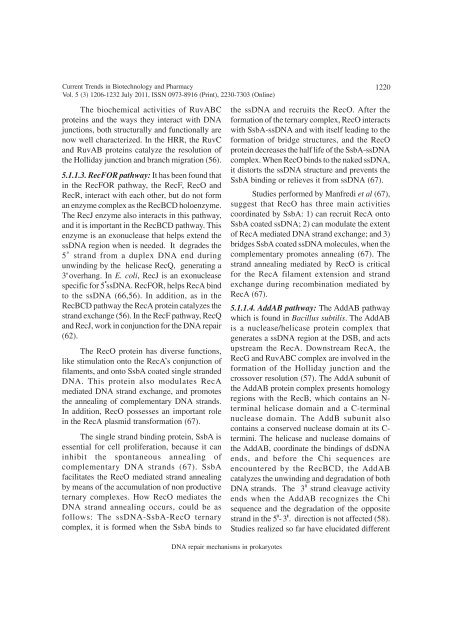full issue - Association of Biotechnology and Pharmacy
full issue - Association of Biotechnology and Pharmacy
full issue - Association of Biotechnology and Pharmacy
Create successful ePaper yourself
Turn your PDF publications into a flip-book with our unique Google optimized e-Paper software.
Current Trends in <strong>Biotechnology</strong> <strong>and</strong> <strong>Pharmacy</strong><br />
Vol. 5 (3) 1206-1232 July 2011, ISSN 0973-8916 (Print), 2230-7303 (Online)<br />
1220<br />
The biochemical activities <strong>of</strong> RuvABC<br />
proteins <strong>and</strong> the ways they interact with DNA<br />
junctions, both structurally <strong>and</strong> functionally are<br />
now well characterized. In the HRR, the RuvC<br />
<strong>and</strong> RuvAB proteins catalyze the resolution <strong>of</strong><br />
the Holliday junction <strong>and</strong> branch migration (56).<br />
5.1.1.3. RecFOR pathway: It has been found that<br />
in the RecFOR pathway, the RecF, RecO <strong>and</strong><br />
RecR, interact with each other, but do not form<br />
an enzyme complex as the RecBCD holoenzyme.<br />
The RecJ enzyme also interacts in this pathway,<br />
<strong>and</strong> it is important in the RecBCD pathway. This<br />
enzyme is an exonuclease that helps extend the<br />
ssDNA region when is needed. It degrades the<br />
5 str<strong>and</strong> from a duplex DNA end during<br />
unwinding by the helicase RecQ, generating a<br />
3 overhang. In E. coli, RecJ is an exonuclease<br />
specific for 5 ssDNA. RecFOR, helps RecA bind<br />
to the ssDNA (66,56). In addition, as in the<br />
RecBCD pathway the RecA protein catalyzes the<br />
str<strong>and</strong> exchange (56). In the RecF pathway, RecQ<br />
<strong>and</strong> RecJ, work in conjunction for the DNA repair<br />
(62).<br />
The RecO protein has diverse functions,<br />
like stimulation onto the RecA’s conjunction <strong>of</strong><br />
filaments, <strong>and</strong> onto SsbA coated single str<strong>and</strong>ed<br />
DNA. This protein also modulates RecA<br />
mediated DNA str<strong>and</strong> exchange, <strong>and</strong> promotes<br />
the annealing <strong>of</strong> complementary DNA str<strong>and</strong>s.<br />
In addition, RecO possesses an important role<br />
in the RecA plasmid transformation (67).<br />
The single str<strong>and</strong> binding protein, SsbA is<br />
essential for cell proliferation, because it can<br />
inhibit the spontaneous annealing <strong>of</strong><br />
complementary DNA str<strong>and</strong>s (67). SsbA<br />
facilitates the RecO mediated str<strong>and</strong> annealing<br />
by means <strong>of</strong> the accumulation <strong>of</strong> non productive<br />
ternary complexes. How RecO mediates the<br />
DNA str<strong>and</strong> annealing occurs, could be as<br />
follows: The ssDNA-SsbA-RecO ternary<br />
complex, it is formed when the SsbA binds to<br />
the ssDNA <strong>and</strong> recruits the RecO. After the<br />
formation <strong>of</strong> the ternary complex, RecO interacts<br />
with SsbA-ssDNA <strong>and</strong> with itself leading to the<br />
formation <strong>of</strong> bridge structures, <strong>and</strong> the RecO<br />
protein decreases the half life <strong>of</strong> the SsbA-ssDNA<br />
complex. When RecO binds to the naked ssDNA,<br />
it distorts the ssDNA structure <strong>and</strong> prevents the<br />
SsbA binding or relieves it from ssDNA (67).<br />
Studies performed by Manfredi et al (67),<br />
suggest that RecO has three main activities<br />
coordinated by SsbA: 1) can recruit RecA onto<br />
SsbA coated ssDNA; 2) can modulate the extent<br />
<strong>of</strong> RecA mediated DNA str<strong>and</strong> exchange; <strong>and</strong> 3)<br />
bridges SsbA coated ssDNA molecules, when the<br />
complementary promotes annealing (67). The<br />
str<strong>and</strong> annealing mediated by RecO is critical<br />
for the RecA filament extension <strong>and</strong> str<strong>and</strong><br />
exchange during recombination mediated by<br />
RecA (67).<br />
5.1.1.4. AddAB pathway: The AddAB pathway<br />
which is found in Bacillus subtilis. The AddAB<br />
is a nuclease/helicase protein complex that<br />
generates a ssDNA region at the DSB, <strong>and</strong> acts<br />
upstream the RecA. Downstream RecA, the<br />
RecG <strong>and</strong> RuvABC complex are involved in the<br />
formation <strong>of</strong> the Holliday junction <strong>and</strong> the<br />
crossover resolution (57). The AddA subunit <strong>of</strong><br />
the AddAB protein complex presents homology<br />
regions with the RecB, which contains an N-<br />
terminal helicase domain <strong>and</strong> a C-terminal<br />
nuclease domain. The AddB subunit also<br />
contains a conserved nuclease domain at its C-<br />
termini. The helicase <strong>and</strong> nuclease domains <strong>of</strong><br />
the AddAB, coordinate the bindings <strong>of</strong> dsDNA<br />
ends, <strong>and</strong> before the Chi sequences are<br />
encountered by the RecBCD, the AddAB<br />
catalyzes the unwinding <strong>and</strong> degradation <strong>of</strong> both<br />
DNA str<strong>and</strong>s. The 3 str<strong>and</strong> cleavage activity<br />
ends when the AddAB recognizes the Chi<br />
sequence <strong>and</strong> the degradation <strong>of</strong> the opposite<br />
str<strong>and</strong> in the 5 - 3 . direction is not affected (58).<br />
Studies realized so far have elucidated different<br />
DNA repair mechanisms in prokaryotes













